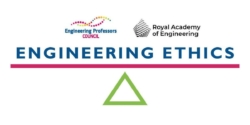 Authors: Professor Thomas Lennerfors (Uppsala University); Nina Fowler (Uppsala University); Johnny Rich (Engineering Professors’ Council); Professor Dawn Bonfield MBE (Aston University); Professor Chike Oduoza (University of Wolverhampton); Steven Kerry (Rolls-Royce); Isobel Grimley (Engineering Professors’ Council).
Authors: Professor Thomas Lennerfors (Uppsala University); Nina Fowler (Uppsala University); Johnny Rich (Engineering Professors’ Council); Professor Dawn Bonfield MBE (Aston University); Professor Chike Oduoza (University of Wolverhampton); Steven Kerry (Rolls-Royce); Isobel Grimley (Engineering Professors’ Council).
Topic: Alternative food production.
Engineering disciplines: Energy; Chemical engineering.
Ethical issues: Sustainability; Social responsibility.
Professional situations: Public health and safety; Personal/professional reputation; Falsifying or misconstruing data / finances; Communication.
Educational level: Advanced.
Educational aim: Practise ethical reasoning. Ethical reasoning applies critical analysis to specific events in order to evaluate, and respond, to problems in a fair and responsible way.
Learning and teaching notes:
This case involves an engineer navigating multiple demands on a work project. The engineer must evaluate trade-offs between social needs, technical specifications, financial limitations, environmental needs, legal requirements, and safety. Some of these factors have obvious ethical dimensions, and others are more ambiguous. The engineer must also navigate a professional scenario in which different stakeholders try to influence the resolution of the dilemma.
This case study addresses two of AHEP 4’s themes: The Engineer and Society (acknowledging that engineering activity can have a significant societal impact) and Engineering Practice (the practical application of engineering concepts, tools and professional skills). To map this case study to AHEP outcomes specific to a programme under these themes, access AHEP 4 here and navigate to pages 30-31 and 35-37.
The dilemma in this case is presented in two parts. If desired, a teacher can use Part one in isolation, but Part two develops and complicates the concepts presented in Part one to provide for additional learning. The case allows teachers the option to stop at multiple points for questions and / or activities as desired.
Learners have the opportunity to:
- determine if an engineering situation / technological development has ethical dimensions and identify what these are;
- identify where tensions might arise between professionals;
- practise stakeholder mapping;
- debate possible solutions to an ethical dilemma.
Teachers have the opportunity to:
- highlight professional codes of ethics and their relevance to engineering situations / technological development;
- address approaches in order to resolve interpersonal and/or professional conflict;
- integrate human and animal consumption industry codes and/or specifications;
- integrate technical aspects of biochemical engineering;
- informally evaluate students’ critical thinking and communication skills.
Learning and teaching resources:
- RAEng/Engineering Council Statement of Ethical Principles
- Power-to-X: How to make (nearly) everything from electricity.
- Power-to-X: The secret to a 100% renewable energy system?
- Opportunities and challenges for renewable P2X
- Food from air
Summary:
Power-to-X (P2X) describes a number of pathways for the transformation of electricity to alternative forms. This can be utilised for storing energy for later use, in order to balance periods of excesses and deficits resulting from the use of renewable energy technologies. It can also be used in applications that do not use electricity, such as through the transformation of electricity to hydrogen or other gases for industrial use.
One area that has seen significant development in recent years is power-to-food (PtF). This pathway results in CO2 being transformed, through chemical or biological processes powered by renewable energy, into food. One such process uses electrolysis and the Calvin cycle to create hydrocarbons from CO2, water and bacteria. The end result is a microbial protein, a substance that could be used in animal feed. Ultimately, the technology could produce a meat alternative suitable for human consumption, further reducing the carbon emissions produced by intensive animal farming.
Optional STOP for questions and activities:
1. Activity: Identify the potential harms and risks of this technology, both objective and subjective. For example, could the shift of food production from soil to chemical industries concentrate power in the hands of a few? What public perceptions or cultural values might impact the acceptance or uptake of the technology?
2. Discussion: Wider context – What social, technological, economic, environmental, political, or legal factors might need to be considered in order to implement this technology?
3. Activity: Research companies that are currently developing P2X technologies. Which industries and governments are promoting P2X? How successful have early projects been? What obstacles exist in upscaling?
4. Activity: Undertake a technical activity in the area of biochemical engineering related to the storing and transforming of renewable energy.
Dilemma – Part one:
You are the Chief Technical Officer at a company that has developed PtF technology that can convert CO2 to edible fatty acids (or triglycerides). The potential of CO2 capture is attractive to many stakeholders, but the combination of carbon reduction tied in with food production has generated positive media interest. The company also intends to establish its PtF facility near a major carbon polluter, that will reduce transport costs. However, some nearby residents are concerned about having a new industrial facility in their area, and have raised additional concerns about creating unsafe food.
As part of the process to commercialise this technology, you have been tasked with completing an ethical assessment. This includes an analysis of the technology’s short and long-term effects in a commercial application.
Optional STOP for questions and activities:
1. Discussion and Activity: Identify different aspects of the production process where ethical concerns may arise, from production to delivery to consumption. Which ethical issues do you consider to be the most challenging to address?
2. Discussion: What cultural values might impact the ethical assessment? Does trust play a role in our ethical and consumption decisions? What internal logics / business goals might steer, or influence, the acceptance of various ethical considerations?
3. Discussion: Which areas of the ethical assessment might stakeholders be most interested in, or concerned about, and why?
4. Discussion: Does the choice of location for PtF facilities influence the ethical assessment? What problems could this PtF technology solve?
5. Discussion: What competing values or motivations might come into conflict in this scenario? What codes, standards, or authoritative bodies might be relevant to this? What is the role of ethics in technology development?
6. Activity: Assemble a bibliography of relevant professional codes, standards, and authorities.
7. Activity: Research the introduction of novel foods throughout history and / or engineering innovations in food production.
8. Activity: Write up the ethical assessment of the business case, and include findings from the previous questions and research.
Dilemma – Part two:
You deliver your ethical assessment to your manager. Shortly afterwards you are asked to edit the report to remove or downplay some ethical issues you have raised. The company leadership is worried that potential investors in an upcoming financing round may be dissuaded from investing in the company if you do not edit these sections.
Optional STOP for questions and activities:
1. Discussion: Professional and ethical responsibilities – What are the ethical implications of editing or not editing the report? What consequences could this type of editing have? Think about stakeholders such as the company, potential investors and society.
2. Discussion: Wider considerations of business ethics – How would you recognise an ethical organisation? What are its characteristics? What is the role of ethics in business?
Enhancements:
An enhancement for this case study can be found here.
This work is licensed under a Creative Commons Attribution-ShareAlike 4.0 International License.
Any views, thoughts, and opinions expressed herein are solely that of the author(s) and do not necessarily reflect the views, opinions, policies, or position of the Engineering Professors’ Council or the Toolkit sponsors and supporters.




